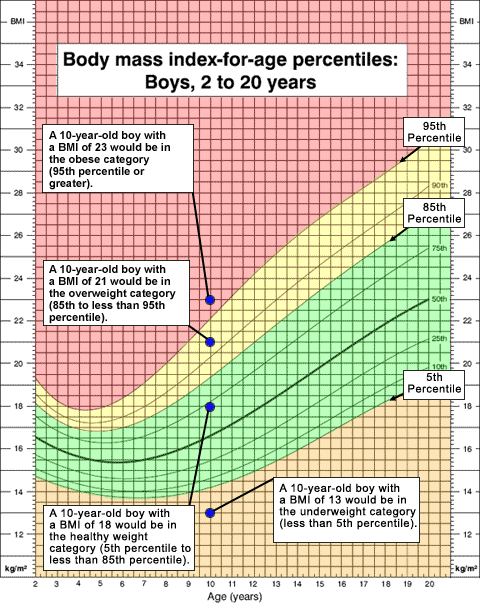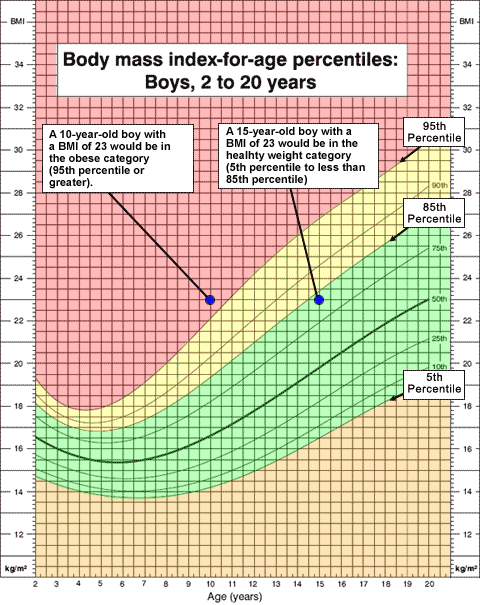Body mass index (BMI) is a person’s weight in kilograms divided by the square of height in meters. It is an inexpensive and easy-to-perform method of screening for weight categories that may lead to health problems.
For children and teens, BMI is age- and sex-specific and is often referred to as BMI-for-age. In children, a high amount of body fat can lead to weight-related diseases and other health issues. Being underweight can also put one at risk for health issues.
A high BMI can indicate high body fatness. BMI does not measure body fat directly, but BMI is correlated with more direct measures of body fat1,2,3.
-
How is BMI calculated for children and teens?
Calculating BMI using the BMI Percentile Calculator involves the following steps:
- Measure height and weight. Refer to Measuring Children’s Height and Weight Accurately At Home for guidance.
- Use the Child and Teen BMI Calculator to calculate BMI. The BMI number is calculated using standard formulas.
-
What is a BMI percentile and how is it interpreted?
After BMI is calculated for children and teens, it is expressed as a percentile obtained from either a graph or a percentile calculator linked below. These percentiles express a child’s BMI relative to US children who participated in national surveys from 1963-65 to 1988-944. Weight and height change during growth and development, as does their relation to body fatness. Consequently, a child’s BMI must be interpreted relative to other children of the same sex and age.
BMI-for-age – Boys Growth Chart pdf icon[PDF-63KB]
BMI-for-age – Girls Growth Chart pdf icon[PDF-49KB]
BMI calculator for children and teens
The BMI-for-age percentile growth charts are the most commonly used indicator to measure the size and growth patterns of children and teens in the United States. BMI-for-age weight status categories and the corresponding percentiles were based on expert committee recommendations and are shown in the following table.
Weight Status Category Percentile Range Underweight Less than the 5th percentile Healthy Weight 5th percentile to less than the 85th percentile Overweight 85th to less than the 95th percentile Obesity Equal to or greater than the 95th percentile The following is an example of how sample BMI numbers would be interpreted for a 10-year-old boy.

The CDC BMI-for-age growth charts are available at CDC Growth Charts: United States.
-
How is BMI used with children and teens?
For children and teens, BMI is not a diagnostic tool. Instead, it is used to screen for potential weight and health-related issues. If children have a high BMI for their age and sex, a health care provider may perform further assessments to determine if excess fat is a problem. These assessments might include skinfold thickness measurements, evaluations of diet, physical activity, family history, and other appropriate health screenings. The American Academy of Pediatrics recommends using BMI to screen for overweight and obesity in children beginning at 2 years old. For children under the age of 2 years old, consult the World Health Organization (WHO) standards.
-
Is BMI interpreted the same way for children and teens as it is for adults?
BMI is interpreted differently for children and teens even though it is calculated with the same formula. Due to changes in weight and height with age, as well as their relation to body fatness, BMI levels among children and teens are expressed relative to other children of the same sex and age. These percentiles are calculated from the CDC growth charts, which were based on national survey data collected from 1963-65 to 1988-944.
Obesity is defined as a BMI at or above the 95th percentile for children and teens of the same age and sex. For example, a 10-year-old boy of average height (56 inches) who weighs 102 pounds would have a BMI of 22.9 kg/m2. This would place the boy in the 95th percentile for BMI, and he would be considered to have obesity. This means that the child’s BMI is greater than the BMI of 95% of 10-year-old boys in the reference population.
Access the CDC Growth Charts.
For adults, BMI is interpreted as weight status categories that are not dependent on sex or age. Read more: How to interpret BMI for adult BMI
-
Why can’t healthy weight ranges be provided for children and teens?
Healthy weight status is based on BMI between the 5th and 85th percentile on the CDC growth chart. It is difficult to provide healthy weight ranges for children and teens because the interpretation of BMI depends on weight, height, age, and sex.
-
What are the BMI trends for children and teens in the United States?
The prevalence of children and teens who measure in the 95th percentile or greater on the CDC growth charts has greatly increased over the past 40 years. Recently, however, this trend has leveled off and has even declined in certain age groups.
To learn more about child and teen obesity trends, visit Childhood Obesity Facts.
-
How can I tell if my child is overweight or has obesity?
CDC and the American Academy of Pediatrics (AAP) recommend the use of BMI to screen for overweight and obesity in children and teens aged 2 through 19 years. For children under the age of 2 years old, consult the WHO standards. Although BMI is used to screen for overweight and obesity in children and teens, BMI is not a diagnostic tool. To determine whether the child has excess fat, further assessment by a trained health professional would be needed.
For information about the consequences of childhood obesity, its contributing factors and more, see Tips for Parents – Ideas and Tips to Help Prevent Childhood Obesity.
-
Can I determine if my child or teen has obesity by using an adult BMI calculator?
In general, this is not possible. The adult calculator provides only the BMI value and not the BMI percentile. Consequently, it is not appropriate to use the BMI categories for adults to interpret the BMI of children and teens.
However, if a child or teen has a BMI of 30 kg/m2 or higher, the child almost certainly has obesity. A BMI of 30 kg/m2 is approximately the 95th percentile among 17-year-old girls and 18-year-old boys.
-
My two children have the same BMI values, but one is considered to have obesity and the other is not. Why is that?
The interpretation of BMI varies by age and sex. So if the children are not the same age and of the same sex, the interpretation of BMI has different meanings. For children of different ages and sex, the same BMI could represent different BMI percentiles and possibly different weight status categories.
See the following graphic for an example of a 10-year-old boy and a 15-year-old boy who both have a BMI for the age of 23. (Note that two children of different ages are plotted on the same growth chart to illustrate a point. Normally the measurement for only one child is plotted on a growth chart.)

-
What are the health consequences of obesity during childhood?
Obesity during childhood can harm the body in a variety of ways, now and in the future. Learn more about the health consequences of obesity for children.
-
If an athlete or other person with a lot of muscle has a high BMI, is that person still considered to be overweight?
According to the BMI weight status categories, any youth with a BMI >85th percentile but <95th percentile for age and gender would be classified as having overweight and anyone with a BMI >95th percentile would be classified as having obesity. Some older adolescents may be considered to have overweight with a BMI between 25 kg/m2 and 29.9 kg/m2, and to have obesity with a BMI over 30 kg/m2.
However, athletes may have a high BMI because of increased muscularity rather than increased body fatness. In general, a person who has a high BMI is likely to have body fatness and would be considered to be overweight or obese, but this may not apply to athletes. A trained healthcare provider should perform appropriate health assessments to evaluate an individual’s health status and risks.